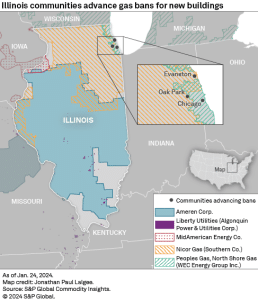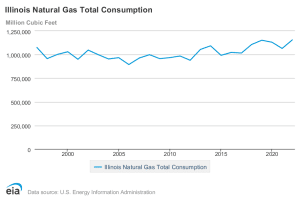In a move with significant developments, Illinois’ governing board overseeing building standards has declined to adopt the all-electric code. The “all-voluntary electrical code” in Illinois refers to a code or set of regulations governing electrical systems and installations in buildings that is optional or voluntary for compliance.
This decision comes amidst a growing trend in northern Illinois, mainly the Chicago communities to curb natural gas use in new construction projects.
The Legal Tussle Between Illinois International Code Council (ICC) and Federal Court
Illinois International Code Council (ICC) discarded an optional all-electric construction code in its 2024 International Energy Conservation Code. It is the standard model for building codes nationwide. The decision to reverse the code echoed a landmark ruling by the US Court.
- However, it has received significant repercussions from the ICC board of directors.
Painting a clearer picture, the advisory council of experts, tasked with updating the state’s building codes over time, initially incorporated the all-electric option into the Illinois stretch energy code.
However, on March 20, the Illinois Capital Development Board (CDB), appointed by the governor, countered this decision by removing the all-electric appendix from the stretch code. This action stemmed from apprehensions regarding potential legal liabilities for communities.
Consequently, Illinois communities will find themselves without a standardized, readily available method for enforcing all-electric new construction.
The insights of this ruling, fetched from S&P Global Market Intelligence are noted below:
- The ICC cautioned cities and states that embracing the 2024 international code’s draft all-electric provision could lead to a “significant risk” of federal law conflicts.
- This decision was influenced by the US Court of Appeals for the 9th Circuit, which held that the federal Energy Policy and Conservation Act (EPCA) preempted Berkeley, Calif.’s pioneering building gas ban.
- The conflict between ICC and CDB highlights the larger impact of obstructing building decarbonization efforts.
- This ruling can affect Western US states and territories. It can also go beyond the regions of the 9th Circuit’s jurisdiction, where courts have not yet addressed EPCA’s compatibility with local electrification codes.
Although the new rule marks a fallout from a nationwide decision, it has established a precedent that challenges local electrification mandates across the country.


Illinois Seeking Sustainable Solutions through CEJA
Illinois located in the heart of the United States, is the nation’s third-largest consumer of gas in both residential and commercial sectors.
While Illinois aims for emission reductions through its Climate and Equitable Jobs Act (CEJA), the clash between state aspirations and federal preemption poses a formidable challenge. The recent decisions highlight the complexity of balancing environmental objectives with legal compliance.
Amidst all the conundrum, Illinois seeks to navigate through the legal and environmental challenges with some sustainable solutions.
Stretch Code Development by CDB
CDB’s Energy Conservation Advisory Council has developed a stretch code in Illinois aimed to align with CEJA’s goals. The climate bill required the CDB to create an optional code exceeding Illinois Energy Conservation Code standards. It would also adhere to international code standards.
It is expected to offer additional measures to enhance building efficiency and reduce emissions. The removal of the all-electric appendix raises doubts about the state’s ability to offer a unified sustainable construction approach.
The stretch code further gives a boost to the rising movement in Chicago and neighboring regions to curb gas and fossil fuel usage in new construction projects.
During the March 20 meeting, numerous local government representatives emphasized to the CDB the importance of efficiency and decarbonization measures in the stretch code. They highlighted that local governments frequently lack the resources to independently develop such policies.
Evanston Mayor Daniel Biss said,
“We rely on the expertise of the state to give us these model ordinances that will be feasible to allow us to achieve our objectives. We are willing to take that risk and prove out the concepts so that other communities can follow.”
Striking a Balance on the Electrification Debate
Differences in opinion and demand among individuals and groups have given rise to the need to balance out the situation. While some from the industry group support 100% electrification others argue for flexibility and affordability. They argue against provisions like the electric-ready requirement, citing potential high costs for homes and threats to energy affordability.
On the contrary, proponents of electrification, like RMI’s Chiu, dispute these claims. He stresses the importance of efficiency measures, such as incentivizing the installation of heat pumps.
However, whatever the outcome is, it must be economically and environmentally viable.
Climate experts emphasize the importance of prioritizing energy efficiency and sustainability. They favor promoting heat pumps and other innovative approaches to achieve climate objectives.
Noteworthy, this strategy aims to mitigate GHG emissions within the community by 60% before 2030. And finally, become net zero by 2050. This aligns closely with recommendations from leading climate scientists worldwide, intending to combat climate change.
The graph shows the total natural gas consumed in Illinois through 2022.


source: US Energy Information Administration
Despite these debates, the Illinois stretch code maintains the all-electric provision, pointing to a continued focus on promoting energy-efficient solutions. Stakeholders will be responsible for reconciling divergent interests while advancing towards a common goal of sustainable development.
Robert Coslow, administrator of professional services at the CDB and chair of the Illinois Energy Conservation Advisory Council has noted,
“The Illinois stretch code pushes builders to install heat pumps through incentives because they are proven to be the most efficient heating source on the market.”
Illinois has set an ambitious goal of achieving 100% clean energy by 2050. To address this, the state utility regulator is examining the future of the gas industry in light of CEJA. However, amidst this transition, there are divergent views on the best path forward.
The next update in 2025 mandated by CEJA will offer an opportunity to reassess contentious issues regarding the all-electric move. Let’s hope the decision paves the way toward a greener future for Illinois and the entire nation.
Disclaimer: The data is fetched from primary source S&P Global Market Intelligence.
- SEO Powered Content & PR Distribution. Get Amplified Today.
- PlatoData.Network Vertical Generative Ai. Empower Yourself. Access Here.
- PlatoAiStream. Web3 Intelligence. Knowledge Amplified. Access Here.
- PlatoESG. Carbon, CleanTech, Energy, Environment, Solar, Waste Management. Access Here.
- PlatoHealth. Biotech and Clinical Trials Intelligence. Access Here.
- Source: https://carboncredits.com/illinois-building-code-update-sparks-debate-with-all-electric-rejection/



